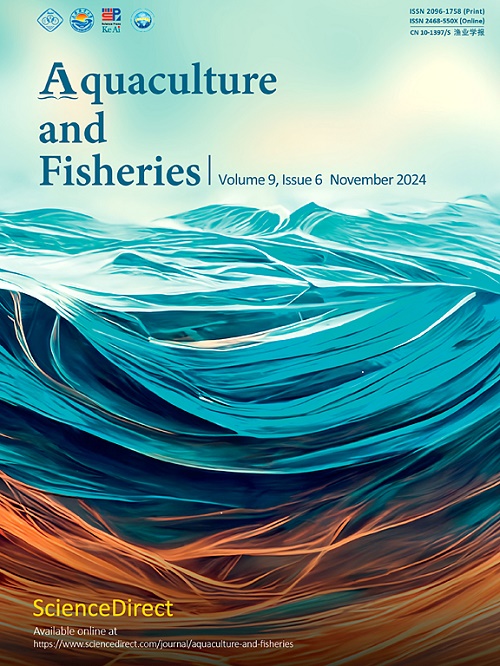cDNA-AFLP-based transcript profiling for the identification of genes functionally related to growth in the pond-reared giant tiger shrimp Penaeus monodon
Q1 Agricultural and Biological Sciences
引用次数: 0
Abstract
Genes exhibiting differential expression patterns between large-sized (average body weight 17.57 ± 1.8 g and 40.97 ± 4.0 g for 3- and 5-month-old juveniles in a total of 342 and 356 samples, respectively) and small-sized (average body weight 10.01 ± 0.76 g and 22.86 ± 2.51 g, respectively) juvenile giant tiger shrimps (Penaeus monodon) were isolated by complementary DNA-amplified fragment length polymorphism (cDNA-AFLP). In total, 368 primer combinations were screened against the first-strand cDNA of the different groups of 3- and 5-month-old P. monodon.
Over 146 differentially expressed or size-specific markers were derived using 59 selective primer combinations. A total of 70 candidate cDNA-AFLP markers—19 size-specific and 51 showing differential expression—were further cloned, sequenced, and blasted against the GenBank database. Twenty-five markers were found to comprise newly identified sequences (E-values >10−4).
Quantitative real-time PCR and Single-strand conformational polymorphism (SSCP) analyses of the products generated with the SCAR/cDNA-AFLP primers were further undertaken. Interestingly, the relative expression levels of the products of primers E+34M+314-550-PDI, E+35M+310-350-Unk, E+29/M+211-350-CHK, E+34/M+31-380-phosphotysosyl, and E+38/M+315-800-fucosidase were significantly upregulated in the hepatopancreas of large-sized juvenile shrimp compared with that is small-sized animals. In contrast, the relative expression levels of the products generated by E+31M+38-480-InositolOxy and E+29/M+211-330-vitelline membrane were significantly upregulated in small-sized P. monodon.
The consistency of our results was further assessed in 1-month-old aquaculture-raised P. monodon. Single nucleotide polymorphisms were identified using SSCP at different positions in the sequences of fragments of the different groups generated with the primers E+34M+314-550-PDI and E+35M+310-350-Unk. Our results indicated that cDNA-AFLP has the potential for use in the isolation of functionally important transcripts in P. monodon.
基于 cDNA-AFLP 的转录本分析鉴定池塘饲养的巨型虎虾中与生长功能相关的基因
利用互补dna扩增片段长度多态性(cDNA-AFLP)技术,分离出大、小对虾幼虾(342份和356份,3月龄和5月龄,平均体重分别为17.57±1.8 g和40.97±4.0 g)和小对虾幼虾(平均体重分别为10.01±0.76 g和22.86±2.51 g)的差异表达基因。共筛选了368个引物组合,分别针对3月龄和5月龄单毛单胞虫不同群体的第一链cDNA。使用59种选择性引物组合获得了146种差异表达或大小特异性标记。共有70个候选cDNA-AFLP标记(19个大小特异性和51个差异表达)被进一步克隆、测序,并与GenBank数据库进行比对。发现25个标记包含新鉴定的序列(e值>;10−4)。进一步对SCAR/cDNA-AFLP引物生成的产物进行实时定量PCR和单链构象多态性(SSCP)分析。有趣的是,引物E+34M+314-550-PDI、E+35M+310-350-Unk、E+29/M+ 311 -350- chk、E+34/M+31-380-phosphotysosyl、E+38/M+315-800- focusidase在大型对虾幼虾肝胰腺中的相对表达量较小型动物显著上调。相比之下,E+31M+38-480-InositolOxy和E+29/M+211-330-卵黄膜产生的产物在小型单齿藻中相对表达量显著上调。在养殖1月龄的单斑绦虫中进一步评估了结果的一致性。引物E+34M+314-550-PDI和E+35M+310-350-Unk生成的不同类群的片段序列不同位置,采用SSCP方法鉴定了单核苷酸多态性。我们的结果表明,cDNA-AFLP有潜力用于分离单殖单胞虫的功能重要转录本。
本文章由计算机程序翻译,如有差异,请以英文原文为准。
求助全文
约1分钟内获得全文
求助全文
来源期刊

Aquaculture and Fisheries
Agricultural and Biological Sciences-Aquatic Science
CiteScore
7.50
自引率
0.00%
发文量
54
审稿时长
48 days
期刊介绍:
 求助内容:
求助内容: 应助结果提醒方式:
应助结果提醒方式:


